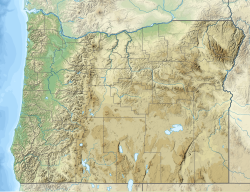| Battle Ax | |
|---|---|
| Highest point | |
| Elevation | 5,566 ft (1,697 m) NAVD 88 [1] |
| Prominence | 1,018 ft (310 m) [2] |
| Coordinates | 44°49′36″N122°08′23″W / 44.826610442°N 122.139590469°W [1] |
| Geography | |
| Location | Marion County, Oregon, U.S. |
| Parent range | Cascades |
| Topo map | USGS Battle Ax |
| Geology | |
| Rock age | 1 to 2 million years |
| Mountain type | Shield volcano |
| Volcanic arc | Cascade Volcanic Arc |
| Last eruption | 1 million years ago |
| Climbing | |
| Easiest route | Trail hike [3] |
Battle Ax [4] is a shield volcano in the West Cascade Range of Oregon. The shield is mostly made of andesite. [5] The summit, which can be reached via the Battle Ax Mountain trail, [3] marks the boundary between the Mount Hood National Forest and the Willamette National Forest as well as the boundary between the Opal Creek Wilderness and the Bull of the Woods Wilderness. [2]
Contents
Battle Ax was supposedly named after the variety of chewing tobacco used by a local logger. [6] [7]
